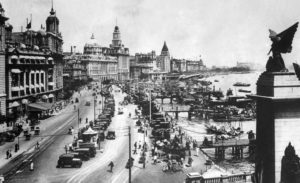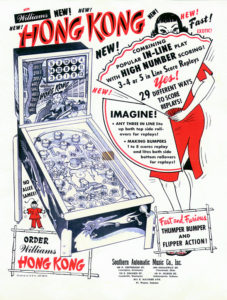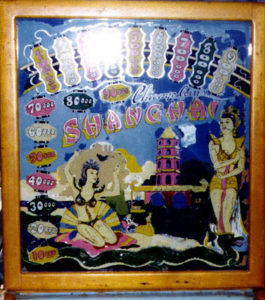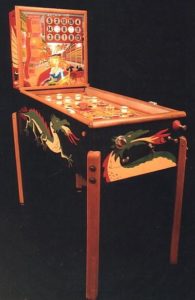Posted: August 10th, 2018 | 1 Comment »
One of Macao’s most iconic modernist buildings is under threat – the Rainha Dona Leonor Housing Block on the Praia Grande, Macao. The building was designed and built in 1958 by Jose Lei Ming-can and was the first modernist high rise in Macao with an elevator. The balconies are particularly noted as are the duplex apartments with external galleries on every second floor. Lei, the architect, was involved in many projects in Hong kong and Macau including HKUST and was a Director of the Hong Kong Architectural Services Department
There is a petition to save the building here


Posted: August 8th, 2018 | No Comments »
Art has always been a crucial component of Shanghai’s cultural history. Some of Shanghai’s esteemed modernist artists, such as Liu Haisu, painted luminous scenes of Fuxing Park and the streets of the Former French Concession (FFC). Even as the arts industry in Shanghai has been expanding from its initial enclave in M50 to the West Bund, the FFC has always been a desirable locale for galleries to showcase works of art.
Please join the Art Focus Convener and Art Historian Julie Chun who will introduce us to three new galleries specializing in contemporary art as we stroll through the tree-lined thoroughfares of the FFC. We will find that each space possesses its unique architectural charm as well as a roster of diverse artists who are inscribing the condition of the times through visual expression. Come discover the arts in your own backyard and expand your understanding of how the local intersects with the global in the artistic sphere of Shanghai.
R.S.V.P. to
Entrance fee
Members:Â 0 RMB
Non-Members:Â 50 RMB
Venue
Meeting point provided on confirmation of RSVP
Posted: August 7th, 2018 | No Comments »
If you are remotely interested in China in all its aspects – old and new, political, social or economic – you really should listen to the Sinica Podcast with Kaiser Kuo and Jeremy Goldkorn. Why not start with their latest episode which has me talking about City of Devils, old Shanghai, researching Republican era China and heritage/preservation issues in China….Click here to listen/download

This week on the Sinica Podcast, Kaiser and Jeremy chat with Paul French, the best-selling author of Midnight in Peking. Paul has just written an outstanding new book called City of Devils: A Shanghai Noir, in which he tells a captivating story of two foreigners rising to prominence through conducting shady business in the underworld of Shanghai in the 1930s — a chaotic yet fascinating period, when the city was still known as the Paris of the Orient, leading up to the bleak realities of the war with Japan.
And…if that’s not enough…you can still listen to the Sinica episode from 2012 where we all (with the Guardian’s Tania Branigan too) all talked about Midnight in Peking – here
Posted: August 6th, 2018 | No Comments »
I owe a great debt to academics and Sinologists – my last couple of books wouldn’t have been possible without the scholarly work of a variety of people including Frederic Wakeman, Robert Bickers, Jonathan Spence, Andrew Field and a host of others…I do try to acknowledge them where possible and (unlike Hilary Mantel!) believe that admitting your debt to academia is important. Now add Paul Bevan to the list…and his new A Modern Miscellany – a fantastic new book on old Shanghai….sadly it’s not cheap so you’ll probably need to be a member of a good library, or recommend your university library to buy….

In A Modern Miscellany: Shanghai Cartoon Artists, Shao Xunmei’s Circle and the Travels of Jack Chen, 1926-1938 Paul Bevan explores how the cartoon (manhua) emerged from its place in the Chinese modern art world to become a propaganda tool in the hands of left-wing artists. The artists involved in what was largely a transcultural phenomenon were an eclectic group working in the areas of fashion and commercial art and design. The book demonstrates that during the build up to all-out war the cartoon was not only important in the sphere of Shanghai popular culture in the eyes of the publishers and readers of pictorial magazines but that it occupied a central place in the primary discourse of Chinese modern art history.
Posted: August 2nd, 2018 | 2 Comments »
A couple of links that may interest those with a fascination for old Shanghai…
I did a “Talking Location” piece with Trip Fiction on Shanghai here…
And another tour of old Shanghai (with slightly different locations and photos) with Book Trail here…

Posted: August 1st, 2018 | No Comments »
I sometimes think of old Shanghai as a city of suicide. Reading the old newspapers it is striking just how many suicides are reported, both Chinese and Shanghailander. The reasons are many and varied but mostly go to the core issues of Shanghai –
- In a town with effectively (beyond a little charity) no safety net people got sick, they didn’t have money for treatment so they committed suicide;
- old age and the fear of unemployment – no pensions and often for rootless and stateless people no families. But this wasn’t always the elderly; Beatrice Den Adel committed suicide in Shanghai at 33, a dancer she feared that as she got too old to dance she’d fall on hard times.
- Financial ruin, gambling debts, opium addiction all feature
- for women the loss, through death or desertion of a male spouse often triggered suicide and a sense of hopelessness.
- Mental illness was of course under diagnosed and under treated and seems to be behind many cases
- and, as in this case today, broken promises – especially hard for people offered a future that is then taken away leaving them stateless, alone and poor…
The Embassy Hotel was on No.7 Carter Road (Shimen No.1 Road) near the junction with the Bubbling Well Road (Nanjing Road West) in the International Settlement. It wasn’t the grandest hotel in town but it was far from the worst. It was managed for many years by Mrs. Jessie Cameron and her staff. In 1933 a Dane by the name of F.M. Bjergfeldt, who was in Shanghai on a contract working for the Danish Great Northern Telegraphy Company, was a long term resident.
Bjergfeldt had taken up with a 24-year-old White Russian emigre called Tamara Tavgueridze. She was described as his fiance. On Sunday July 2 Tamara went to Bjergfeldt’s room, drank poison, and committed suicide. Why she did it? – I don’t know. I can surmise a broken off engagement, a sense of futility living in exile…The Embassy Hotel was quite the place for suicides (many foreigners chose it as a suicide spot). It was said to be a gloomy hotel and perhaps that encouraged suicidal thoughts.
I’m afraid I don’t have a picture of the hotel, but do have this shot of the junction of Carter Road and Bubbling Well Road at the time…which does include the marvelous old Bubbling Well Pharmacy…

Posted: July 31st, 2018 | No Comments »
On the Track of Robert Van Gulik
Friday, 24 August 2018, 7.00pm-9.00pm
Screening in Khalili Lecture Theatre (KLT)

As part of the First London International Guqin Festival, we are pleased to welcome van Gulik’s granddaughter, Marie-Anne Souloumiac – Van Gulik, to the festival to show a special film about her grandfather’s life as a diplomat, writer, Sinologist and qin player.
Robert van Gulik (1910-1967) is one of the world’s most popular Dutch writers, but relatively unrecognised in his own country. A diplomat, Chinese specialist and scholar, he became famous with his detective series about Judge Dee, which in many ways, are projections of his own life: a permanent duality between his real life
and the hero in his books.
Written and directed by Rob Rombout.
Duration: 88 mins.
Spoken in English, Dutch, French, Chinese and Japanese.
Subtitled in Dutch, French or English.
The film screening will be chaired by SOAS Research Associate, Dr Hwee-san Tan.
The tour dates for our concerts in the series are as follows:
20th: Oxford Town Hall (7pm)
23rd: Emmanuel United Reformed Church, Cambridge (7pm)
25th: DLT, SOAS (7.30pm)
26th: DLT, SOAS (7pm).












